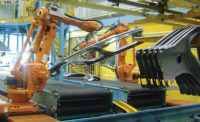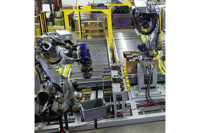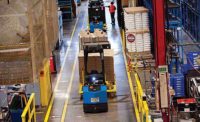Vision-Guided Robots Improve Nut Welding
Machine vision lends flexibility to robotic welding cell

Running at a 20-second cycle time, the VERA cell is expected to produce 400,000 each of two part numbers in its first year of operation. Photo by Tim Jacobs, courtesy D&D Automation Inc.

D&D Automation’s VERA cell uses two vision-guided robots to install weld nuts in an auto part. Photo by Tim Jacobs, courtesy D&D Automation Inc.

After the vision system identifies a part traveling down a conveyor, a robot picks up the part and positions it on the welder. Photo by Tim Jacobs, courtesy D&D Automation Inc.

The vision system is mounted above the conveyor and identifies parts using a pattern recognition algorithm. Photo by Tim Jacobs, courtesy D&D Automation Inc.

D&D Automation used an In-Sight 7200 vision system from Cognex Corp. for its robotic welding cell. Photo courtesy Cognex Corp.





Weld nuts are installed on steel plates or sheets to provide firm, fixed threads for a mating screw or bolt. They are welded around holes that have been punched or drilled into the metal. They generally have a flange with small nubs that melt to form the weld. Weld nuts are used heavily in the automobile, appliance, consumer products and medical equipment industries.
The fasteners are typically welded to parts using a semiautomatic cell equipped with a fixture designed specifically to hold the part and nuts in position. The operator takes a part out of a bin, loads it in the fixture, steps back and hits two safety buttons. With the operator out of the way, the machine clamps the part in place. The operator then walks forward, takes nuts out of a bin, and loads them into position on the fixture. After loading the nuts, the operator again steps back to press the safety buttons, and a resistance welder is activated to weld the nuts to the part.
Some parts require multiple nut sizes to be welded. That typically means separate feeders, tooling and hardware for each nut size. In some cases, multiple nut sizes require completely separate cells. Cells can potentially be repurposed for new parts, but this is usually not done because the original machines are needed to build aftermarket parts in smaller volumes. Separate cells are often used for different size nuts because of the risk that the wrong sized nut could be installed. Each cell requires an operator as well as its own maintenance costs and upkeep.
A Different Way
D&D Automation has developed a new Vision-Enabled Robotic Assembly (VERA) cell that uses two vision-guided robots to handle multiple parts and multiple nut sizes without requiring special fixtures or the full-time attention of an operator.
The vision system identifies a part traveling down a conveyor, and a robot picks up the part and positions it on the welder. A second vision system then identifies the right sized nut, and a second robot positions it onto the part. The robot can position multiple nuts of different sizes for a single welding operation. A resistance welder then welds the nuts onto the part. This new approach requires only 25 percent to 50 percent of an operator’s attention and can handle many different parts without requiring special fixtures.
Based in Stratford, ON, D&D Automation is primarily a controls integrator that designs and implements PLC-based control systems for industrial machinery, manufacturing lines, process environments and other automated facilities.
The company’s engineers originally had the idea of providing a pre-engineered system for seam welding using vision-guided robots. Seam welding involves putting two metal parts next to each other and running a welder along the seam. The challenge is that the welder needs to run right along the seam within a tolerance of less than a millimeter to produce good parts.
With a traditional seam welder, it is problematic if the seam moves a millimeter to one side or the other, as the final assembly will likely have to be scrapped. D&D developed a solution that uses a 3D vision system to track the position of the seam and provide instructions to a robot that will follow the seam regardless of how much it moves.
The prototype worked well, but the first potential customer that D&D showed it to said: “This is very nice, but our real problem is nut welding.” While the seam welder remains a viable technology, D&D’s focus shifted to fasteners. D&D engineers went back to the drawing board and applied their VERA technology to the nut welding problem.
The first system built by D&D welds nuts on an A-pillar made by a major automotive supplier for a 2014 model vehicle. D&D used ABB IRB140 and IRB2600 industrial robots and Cognex In-Sight 7200 vision systems for this application.
“We selected Insight 7200 vision systems because they provide 800 by 600 pixel resolution-six times the processing speed of the base In-Sight Micro 1020 model-and PatMax pattern matching capabilities at an economical price,” says Michael McCourt, president of D&D Automation. Like all Cognex In-Sight 7000 series vision systems, In-Sight 7200 vision systems have autofocus capability. That feature simplifies setup and is good for production situations requiring regular part changes or where the vision system is hard to reach.
How It Works
To begin, a single operator loads parts onto an infeed conveyor. A vision system mounted above the conveyor identifies the part using the Cognex PatMax pattern recognition algorithm. D&D engineers used the Cognex EasyBuilder user environment to program the vision operations. Configuring the system to locate and identify a part is as simple as capturing an image of each part.
The vision system is programmed to look continuously for all of the parts being run. When PatMax recognizes a part in the image, it signals the PLC to stop the conveyor. The vision system captures another image to determine the exact location and orientation of the part. It then passes the part’s X, Y and theta coordinates to the robot controller, which directs the first robot to pick up the part and place it on the resistance welder. A special fixture is not needed because the robot places the part much more accurately and repeatedly than could be accomplished by a human operator.
A second vision system then examines the assortment of nuts on a nut handler and picks out a nut of the proper size. Here, too, the vision system uses the PatMax pattern recognition algorithm. The vision system also sends a signal to stop the nut handler, and it captures a second image of the nut to accurately determine its position. Because of the nut’s symmetrical geometry, there is no need to determine the orientation of the nut. A second, smaller robot then picks up the nut and positions it correctly on the part.
The robot and vision system can pick as many nuts as are needed to complete the assembly, regardless of their size or shape. After each nut is in place, the PLC actuates the resistance welder. The first robot then indexes the part for the next nut. When all the nuts have been welded, the robot removes the part from the welder and puts it on an outfeed conveyor.
Running at a 20-second cycle time, the system is expected to produce 400,000 each of two part numbers in its first year of operation. At full capacity, it can produce 800,000 parts per year. This system will require only 50 percent of the attention of one operator, who will spend the other 50 percent of his time operating another cell. All the operator has to do is load parts from a bin onto the inflow conveyor and offload parts from the outflow conveyor into another bin.
Advantages of New Approach
Most manufacturers have a large number of parts that require nut welding. In many cases, a different cell is needed for each part. With the new approach, each flexible cell can accommodate an unlimited number of different parts and nut sizes. By designing a cell this way, the only variable is how many parallel cells are essential to meet the desired production. The cells also provide redundancy in the event of a maintenance shutdown.
The typical cell can handle any size part from 4 to 36 inches long. There is no limit on the number or the size of the nuts. If four cells were set up together, one operator could run all of them.
For more information on vision-guided robotic workcells and a short video of this technology, call 519-273-7282 or visit www.ddauto.com.
For more information on Cognex vision systems, call 877-COGNEX1 or visit www.cognex.com.
Looking for a reprint of this article?
From high-res PDFs to custom plaques, order your copy today!










